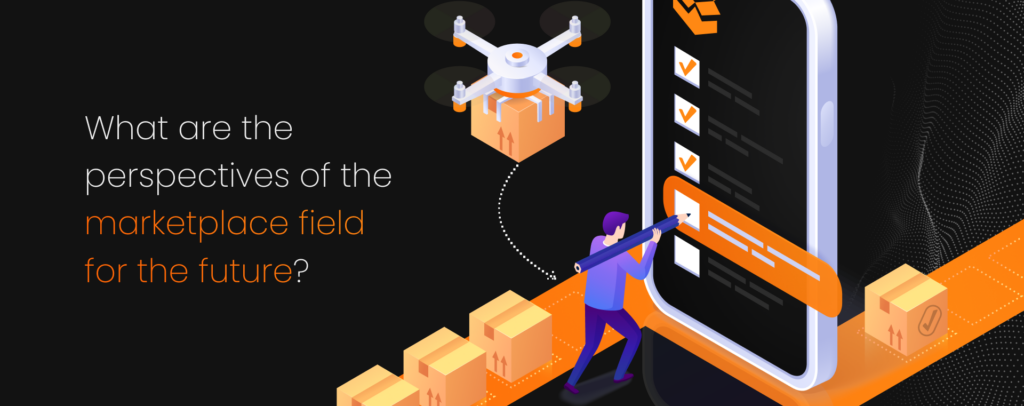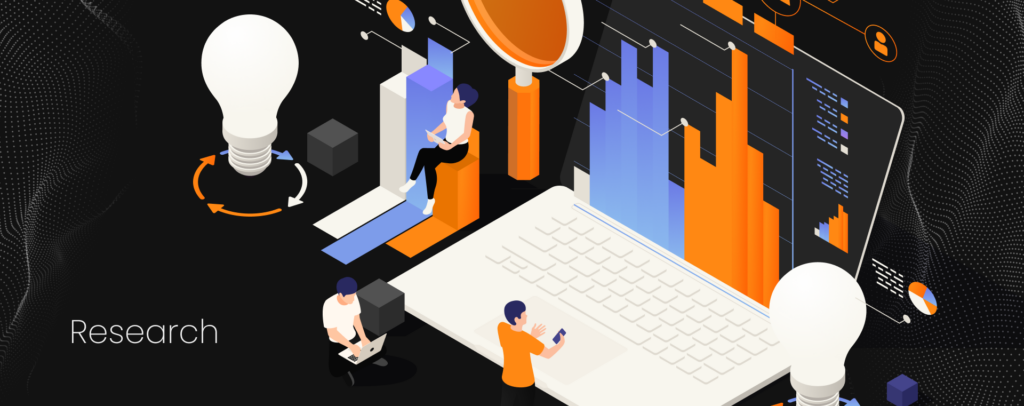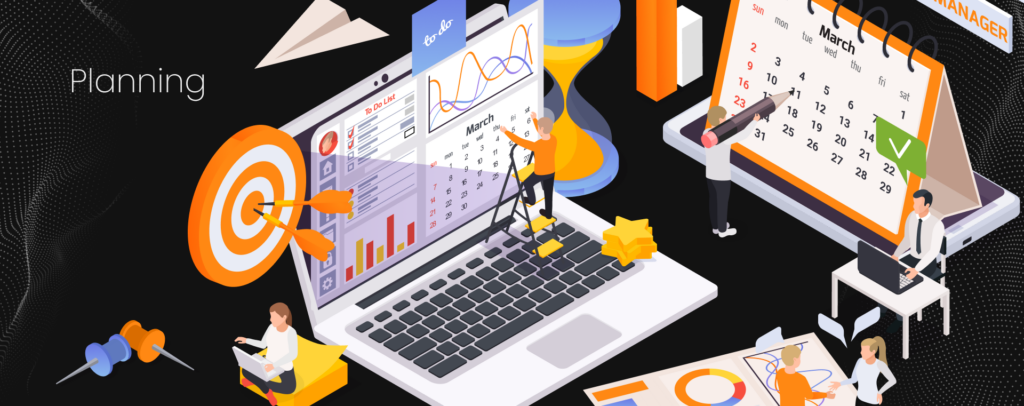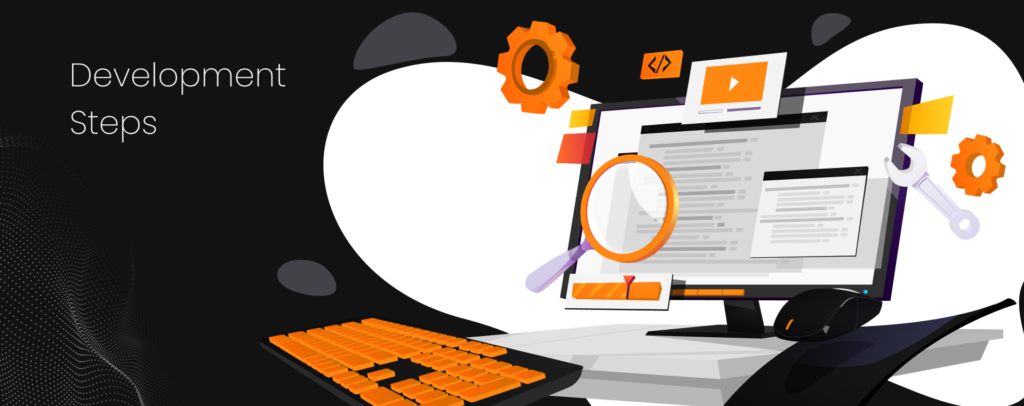Online shopping was rapidly developing even before the global pandemic, but it certainly gave the eCommerce area a massive boost. The best thing about launching a marketplace, you don’t need to own any products or goods. You simply give people a platform to make transactions and gain profit from it.
In this article, we’ll break down the costs of building a marketplace with Magento, from the early stages of research and planning to full-cycle development. After reading it, you will know expenses you’ll have after you hire a dedicated eCommerce development team.
What are the perspectives of the marketplace field for the future?

The first thing you need to know about starting your own business is that not every startup starts with a perfect idea. Sometimes, you need to adapt your business model to the market’s current needs to succeed.
That being said, online shopping is at its peak today. Global retail eCommerce sales are expected to reach 5.4 trillion US dollars by the end of 2022. Meanwhile, the biggest marketplaces sold 2.67 trillion US dollars in 2020.
There’s huge potential for setting and developing your own marketplace because you can enter the market with minimum investment and start gaining income in the short term. Let’s dive deeper into exactly how much money you need to spend on your marketplace project.
What are the costs?
Building an online marketplace is a time-consuming process with a lot of expenses to cover. Let’s take a look at some of the components that together make up a cost of building an online marketplace.
Magento expenses
Naturally, this is the first set of expenses you’ll face when building a marketplace with Magento. Currently, Magento has three options to choose from:
- Magento Open Source. This free version of the platform has all the necessary features, such as basic site administration, responsive web designs, standard shipping options, etc.
- Magento Commerce. This option will cost you XXX. It includes such functions as advanced targeting, segmentation, content management, and cloud features.
- Magento Commerce Cloud. For this option, you’ll pay XXX. With Magento Commerce Cloud, you won’t have to worry about purchasing any additional functionality because it provides business owners with full infrastructure to develop an online marketplace.
Payment solutions expenses
The next significant part of expenses is reliable payment systems to manage online transactions. There are three ways you can go about organizing the proper transaction process between your buyers and sellers.
Direct payments
With direct payments, your platform isn’t involved in the transactions. However, this option means you don’t have many options for charging fees and taking care of refunds and returns. Also, your clients won’t be able to buy goods from various sellers and pay for all the products in one go; they’ll need to go through the checkout process with each seller individually.
Aggregated payments
This way, your platform collects the buyers’ money and later distributes it among the sellers. You’ll have more control over the transactions, and it also enables an option of single checkout, which is more convenient for the customers. On the other side, you’ll need to handle vendors’ finances and ensure regular payouts on your platform.
Parallel payments
This method involves integration with third-party payment services. The payment providers handle all the transactions and distribute buyers’ money between the sellers and your platform. They are also responsible for security compliance. Most online marketplaces go for this option because it is convenient and secure. The question is what payment provider to choose because there are plenty of options on the market. PayPal, Stripe, and Authorize.net are among the most popular payment systems. Let’s review them:
- PayPal. It charges 2.9% + $0.30 for every transaction over $10.
- Stripe. It charges 2.9% + $0.30 per successful transaction.
- Authorize.net. It charges $25 monthly, plus 2.9% + $0.30 per transaction.
Domain expenses
The domain name is the address of your marketplace website. It makes it easier for users to search for your website and visit it. When choosing a domain, keep in mind the following:
- It should be connected to your brand
- Don’t make it too complicated
- Avoid using numbers and/or hyphens
- Make it SEO-friendly (use relevant keywords in the naming)
Be ready to go through many options for domain names before finding the perfect one for your marketplace. The prices for domains range from $10 to $100 a year though some premium options may cost you even $1000.
Web hosting expenses
You need a space to store all of your marketplace files. That’s where web hosting comes in. When users search for your website in the browser, its name is converted to the IP address of your web hosting provider’s computer. It stores all of your marketplace’s data and transmits it back to the visitor’s browsers. There are two types of web hosting to consider:
- Virtual hosting. This hosting means that you host your website on the virtual shared server and store your data alongside the data of others. It’s a better option for small businesses and startups because it has all the necessary flexibility and features for relatively low prices. The prices range from XXX to XXX.
- Dedicated hosting. With dedicated hosting, you have your own server to use. The prices range from XXX to XXX.
SSL certificate expenses
Technically, that’s not a necessity, but with an SSL certificate, you gain many benefits. It protects the data of your marketplace’s users and strengthens security. An SSL certificate is applied whenever there’s a data transfer between a marketplace’s website and a web server. As a plus, search engines rank those websites with SSL certificates higher. The prices range from 15 euros.
Want to build your own marketplace, but don’t know where to start?
Contact our team, and they will get back to you shortly, ready to answer all the questions and help build your version of Airbnb or Amazon today.
A development team to build a marketplace: in-house vs outsource
Development is another major expense that will take most of your budget, so we’ve dedicated a whole new chapter to this.
When building a marketplace, you ought to have these specialists in your team:
- The project manager has experience in building marketplaces before and knows how to manage the team members and handle the work processes
- UI\UX designer to create user-friendly interfaces so your customers can easily navigate through complex technical landscape
- Web developers to build the platform
- QA engineers test the product and ensure that it works just as it is supposed to
Now, the main question in finding these specialists is whether you want to have an in-house development team or go for outsourcing.
With an in-house team, you’ll have full control over the development process and will be able to make changes to the process at once. At the same time, hiring a development team is quite costly since you’ll have to pay a salary and provide working conditions for each team member. And even the smallest projects require at least one developer, designer, QA engineer, and so on.
Another option is outsourcing, which is quite a popular approach to development among eCommerce business owners. It’s cost-effective, easy, and ensures high quality of development. With so many options on the market, you can find the right development team with professionals who have the exact skills and knowledge to build your marketplace. You can learn more about the pros and cons of each option here.
How to create a marketplace in 4 steps?
In order to create a successful marketplace, follow these steps:
- Conduct proper research and analyze the leading companies in the niche, competitors, and target audience. Check whether your idea is viable before spending your resources on building an online marketplace.
- Gather all of the requirements regarding your marketplace idea and turn them into a list of required features and functionality. Prepare specifications about the project and look for the proper development team to build it for you.
- At this stage, your development team will work on building the platform, testing it, and adjusting it to your requirements. You’ll see how the necessary features and functionality are incorporated into the platform.
- After the marketplace is launched, work on marketing strategies to create a successful marketplace website promotion.
Now, let’s learn a little bit more about each of the steps and how you should approach them.
Research

So, it’s final; you’ve decided to build your own marketplace. Before choosing the type, platform, and technologies, it’s important to thoroughly research the current market to figure out what will work and what won’t.
You first need to figure out what kind of problem your platform will solve. For instance, Airbnb solves the problem of expensive accommodations for travelers, offering cheaper and more local places. Meanwhile, BlaBlaCar offers a way to travel to the destination even with the inflexible routes and schedules of trains and buses.
Once you’ve determined what kind of problem your marketplace will solve, take a look at the competitors’ markets. While all of the potential niches could be already taken, you have to figure out a narrower angle to make your platform unique.
You also need to research your target audience. Who are they, and what are their expectations and demands? Once you’ve come up with the list of those, you can easily turn them into features and functionality for the future platform.
Planning

The next step is to plan how you will carry out every part of the project. If you find the right development team, they will provide you with such a service. For instance, there are business analysts who determine your business needs and technical, functional, and usability requirements.
After that, you’ll be able to create detailed project specifications, with such details as the platform’s features, tech stack, API integrations, etc.
Development steps

The next major step of marketplace building is the development stage. It’s the part that takes up most of the project work and can be divided into several steps itself. Let’s review some of the steps besides the coding itself.
Make a prototype and test the idea
First, you need to create a prototype of your future marketplace. A prototype can be as simple as a sketch made with pen and paper. But, working with a web development company, you’ll get something more elaborate, like an interactive HTML model or a first-rate marketplace website prototype.
Even though prototypes aren’t functional, they allow you to attract the audience, validate the idea, and find your first investments.
Create a project documentation
The next step is to lay out all the details of the project. When creating project specifications, you’ll need to include such things as a number of features and their complexity, third-party integrations and add-ons, design, etc.
Why doing this? Often clients and developers have different visions of the project details and how they have to be implemented from the technical perspective. At this stage, you ensure that everyone is on the same page regarding the smallest details of the project.
Develop a marketplace website MVP
The next step is building a minimum valuable product or just an MVP. That’s a part you don’t want to overlook because it helps to validate the project’s idea and optimize time to the market with minimum investments.
When building an MVP, the main objective is to create a marketplace with enough functionality and collect the initial feedback from the users. The must-have features of the marketplaces include user accounts, profiles and settings, search and filters, real-time chats, payment methods, reviews, ratings, etc. Some of the advanced features of the marketplace platform include wishlists, price comparisons, advanced search, sortings, etc.
Expand your client base

Once you’ve released the product, you want to see loads of sellers and buyers engaging with it. But it may take some time to grow the pool of customers, both sellers, and buyers. This is why it’s crucial to start growing your customer base long before the marketplace release.
You need to make sure that on the launch day, you have a vital community of users engaging with each other. If your marketplace is nothing but a ghost platform right from the start, it will be hard to find new users and make your marketplace look trustworthy.
Post-development
Most business owners think that all of the work is done once the development stage is over. While It’s true that the development part takes up most of the project’s time, post-development is of no less importance.
You need to develop a strategy for attracting your first clients. When creating a marketplace, who should these clients be anyway, sellers or buyers? You better start with finding a solid base of sellers offering a wide range of products who don’t expect to get lots of sales at once. Make sure to communicate to your sellers that while your project is only starting, it can become a steady source of income for them in the future. Where to find such sellers? Try these methods:
- Contact sellers on the competitive marketplaces
- Look through online forums, Facebook groups, etc
- Search for sellers to cover your unique niche on Google, etc
Final thoughts
When it comes to building a marketplace with Magento, there are different expenses and costs you need to consider. Let’s review the main parts again:
- Magento expenses
- Payment solution expenses
- Development expenses
- Domain expenses
- SSL certificate expenses
- Web hosting expenses
The exact prices depend, of course, on the size and complexity of the projects. However, no matter size and complexity, development costs almost always take up most of the budget. Find a reliable web development team, and they will help you with the development and other parts of the project realization.
If you have an idea for a marketplace but don’t know how to start implementing it or just have some questions left, don’t be shy and contact us. Our team will get back to you shortly.
